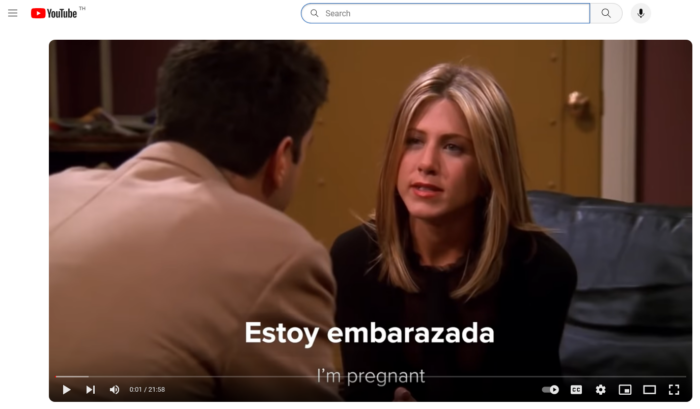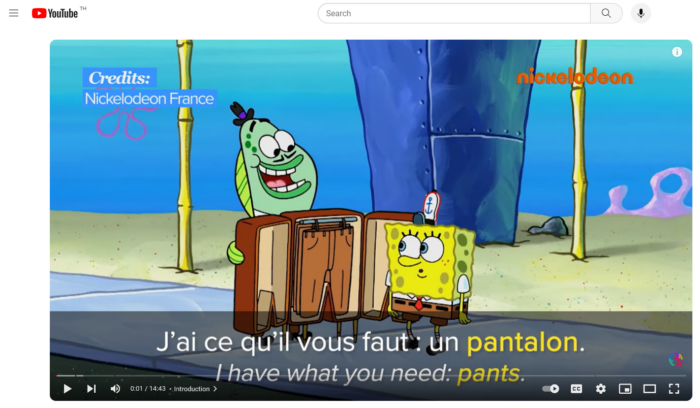Benefits of Subtitled Video for Learning a New Language
Read other articles:
Back to posts
Table of Contents

Unless you’re already fluent in a foreign language, you’re probably going to need subtitles to watch a movie, TV program or other video in the language you’re learning.
Subtitles not only facilitate understanding of the plot, dialogue or topic meaning for the viewer but can also enable the use of valuable language learning tools/apps designed to work with video.
The use of subtitles is on the rise in the U.S. and elsewhere. But what’s the best way to use subtitles to accelerate your foreign language learning?
When you’re choosing videos to assist with the language-learning experience, what should you be looking for?
And what tools can help with this process?
Let’s get into it…
The value of subtitled video for learning a language
It’s no exaggeration to say that video (especially when combined with cloud and AI technology) has reshaped the language-learning landscape in the past two decades.
There’s LOTS of video content around — and watching it is probably the easiest way to immerse yourself in a language if you can’t constantly surround yourself with native speakers. That makes video an effective language-learning tool in itself.
Online language immersion is already an established and effective way to learn a language. There’s an almost limitless supply of video available on almost any topic, with native speakers using language of different proficiency levels, and with subtitles freely available. This has made YouTube an online classroom for many self-motivated language students around the world.

Video provides exceptional benefits for language learners:
- Virtual access to native speakers in almost any language
- Engagement, motivation, and inspiration to aim higher
- An anxiety-free learning environment, which is best for learning a language
- Memorable content (the viewer’s attention is highly focused)
- Cultural context, which deepens the learning experience and adds meaning to it
- Both active and passive learning opportunities: simply follow what’s going on or pause/rewind/replay and take “notes” as you learn.
Types of videos to look for on YouTube
It’s not just movies that can help you learn. Any video can be useful for acquiring a foreign language, providing it ticks three main boxes:
- Highly engaging
- Has repetitive or recognizable elements (you already know roughly what’s going on)
- Has subtitles
So, apart from learning a language from movies, you can look for the following types of video content on YouTube or your other chosen video platform:
- Videos covering your hobbies and interests
- Your favorite TV shows
- Videos from language teachers
- Videos from polyglots
- Videos on your favorite music channels
- News channels
- TED talks

Benefits of subtitled video
There’s a temptation to switch on subtitles in your native language when watching videos to learn a new target language. But is that productive — and will it accelerate your language acquisition?
Stephen Krashen’s theories of language acquisition stress the importance of all instruction being in the target language. If we’re using video as a learning method, therefore, we should keep the subtitles in the target language rather than switching to our native language.
This goes “against the grain” of the standard approach by language learners, whose default in many cases is to turn on subtitles in their native language. That may actually be counter-productive to foreign language learning — and, as you’ll see in the next section, that’s borne out by the research.
If you’re a native English speaker learning French from a dubbed version of the movie Napoleon, switch French subtitles on — not English. This will provide written as well as spoken cues. Try to follow the plot in French.
If you can’t follow what’s going on, choose simpler videos rather than switching to English subtitles. Language acquisition is best when it is pitched “just beyond “your current level — there’s little point in a relative beginner watching a video with advanced language if they can’t understand what’s going on.

Ultimately, learning a language from subtitled video can:
- Increase reading speed and listening comprehension: these are passive input skills that are essential for effective foreign language learning (it’s not just about speaking and writing output).
- Boost language fluency: it’s tough to make sense of what you read and hear at first with a new language but subtitled video helps you distinguish sounds and separate them into recognizable words and phrases.
- Expand vocabulary: you can build a library of new words and phrases learned in the correct cultural context (especially if you actively pause, rewind, and replay sections where new language appears).
- Improve word recognition and grammar: this occurs naturally and is more effective for efficient language acquisition than traditional forced grammar-learning approaches.
What does the research say about learning languages with subtitles?
A 2009 study published online found that foreign subtitles improve speech perception — but native-language subtitles can harm it. Essentially, the research found that subtitles in the target language were associated with the best performance on both previously heard and new material. Native-language subtitles also enhanced performance on the old items but led to a worse performance with the new materials.
So, hearing and reading a foreign language at the same time helps students’ phonetic understanding of it and helps build familiarity with the vocabulary and sounds of the language.
“Dutch participants, unfamiliar with Scottish and Australian regional accents of English, watched Scottish or Australian English videos with Dutch, English or no subtitles, and then repeated audio fragments of both accents. Repetition of novel fragments was worse after Dutch-subtitle exposure but better after English-subtitle exposure. Native-language subtitles appear to create lexical interference, but foreign-language subtitles assist speech learning by indicating which words (and hence sounds) are being spoken.”
Another study from 2016 went a little deeper and made some interesting findings about subtitles for ESL students. It set out to learn if claims that subtitled films aid foreign learning were true by getting a group of intermediate Spanish students of English to watch a one-hour-long episode of a TV drama in its original English version, with English, Spanish or no subtitles overlaid.
“Before and after the viewing, participants took a listening and vocabulary test to evaluate their speech perception and vocabulary acquisition in English, plus a final plot comprehension test. The results of the listening skills tests revealed that after watching the English subtitled version, participants improved these skills significantly more than after watching the Spanish subtitled or no-subtitles versions. The vocabulary test showed no reliable differences between subtitled conditions. Finally, as one could expect, plot comprehension was best under native, Spanish subtitles.”
Second-language listening ability (which is essential for developing fluency in a foreign language) is improved as long as the subtitles are in the same language as the video.
The strong suggestion, then, is that learning outcomes from subtitled videos are best when the subtitles are in the target language rather than the native language.
Learn a foreign language from subtitled video…
Evidently, subtitled video in the target language is an effective way to improve foreign language learning.
Whether you’re watching a YouTube movie, TV program, language tutor video or newscast in your target language, turn on the subtitles in the target language if that option is available.
Intermediate to advanced English learners will be able to adapt to the target language’s sounds more efficiently and should immediately start seeing the benefits for language fluency.
If you’re an absolute beginner, try very basic, short, kids’ videos and animated movies or find online language tutors who prepare videos for newbies. Rewatch again and again — repetition is good.
If you already follow Netflix, HBO, Amazon Prime or Disney+ series daily or weekly, switch on the subtitles in the target language to receive some passive benefits from watching.
Try watching your favorite TV show or movie (that you already know the plot to) with subtitles — you’ll spend less mental energy working out what’s going on and more on reading and listening to how the language is used.
An app to help you learn…
For subtitled YouTube videos, the best language-learning app to accompany you on your journey is a free Chrome extension that you can download here. This combines the best of AI with human learning to help you build a deeper understanding of your target language.
By saving newly learned language to a personalized library, you can throw away your notebook and use subtitled videos to help build language fluency — both actively and passively.
Read other articles:
Back to posts
